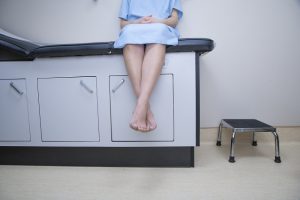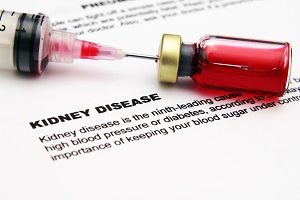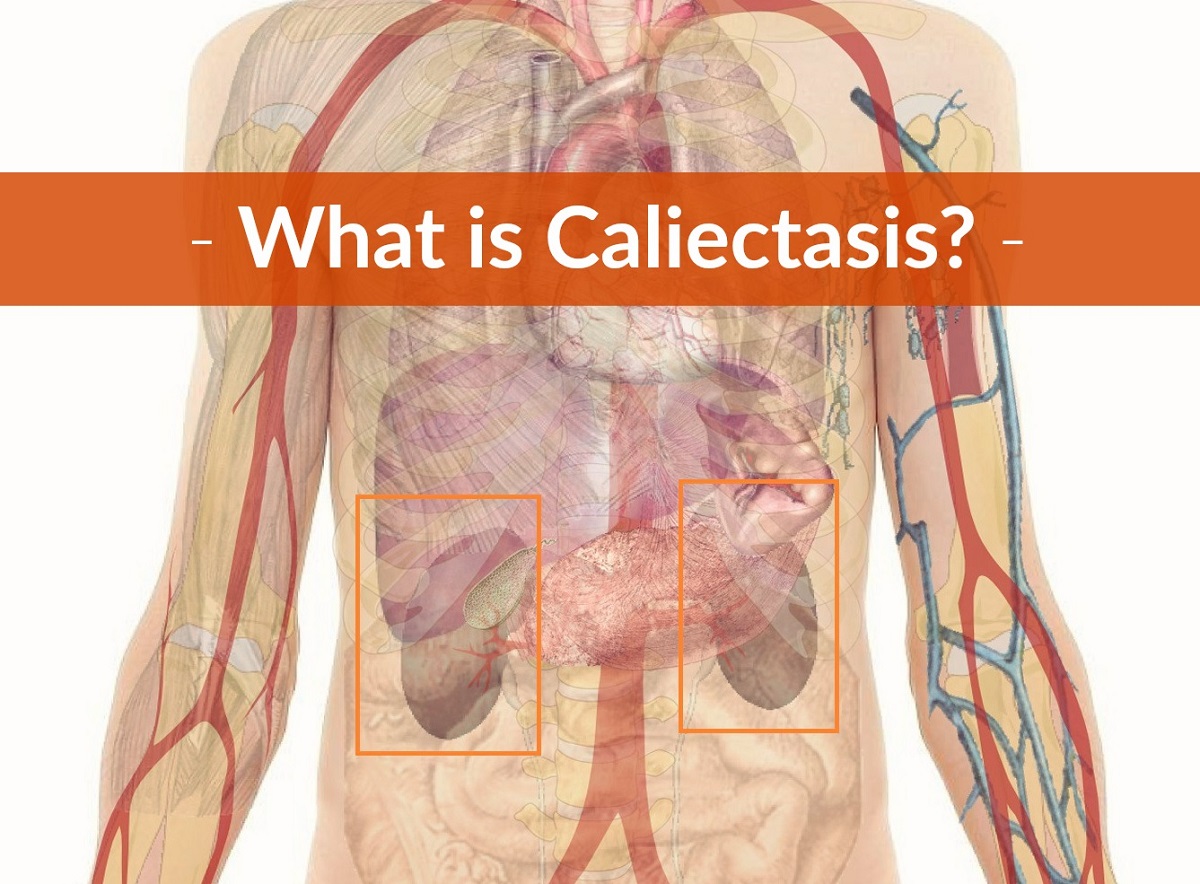Caliectasis (hydrocalycosis) is a medical condition that occurs when the calyces, within the renal pelvis, become dilated.(1,2)
Calyces are found within the kidney and are part of the system which filters and drains the body’s urine into the ureter. The major calyx is contained from two or three minor calyces which are then divided into 7 or 14 smaller vessels.
In the ureter, body fluids are moved to the bladder and, as necessary, eliminated via the urethra. When a person has caliectasis, the fluid reverses to the kidneys and urinary retention is observed. Over time, distension of the calyces occurs.
A patient with caliectasis is most frequently seen by a nephrologist (a physician specializing in the kidney and renal system) or urologist (or a physician specializing in the urinary tract).
Caliectasis Causes
A variety of causal factors may result in caliectasis, or the appearance of the condition, including:(3,4)
» Any blockage in the patient’s urinary tract, from a mass, kidney stones, or iatrogenic effects;
» Blood clot(s) impeding the urinary tract;
» Tight bladder muscles causing urine flow to alter, feces accumulation in the colon; prostatic growth or enlargement; or bladder flexing;
» Urinary tract infection (UTI) causing swollen calyces;
» Bladder cancer or other mass pressing on the renal system;
» Retroperitoneal fibrosis, such as when the degree of renal failure exceeds the degree or dilation;
» Structural congenital malformations as the result of injury, radiation therapy, or surgery that may cause hydronephrosis.
Doctors sometimes misinterpret calyces dilation as prominent renal pyramids, especially in children and young adults.(5)
Symptoms
Patients often say it is difficult to urinate and may begin to pass blood in the urine. Presenting symptoms include painful and tender kidneys upon palpation. In some instances, the doctor feels swelling at the kidney site.
Because the patient may have a urinary tract obstruction, kidney infection or another medical condition, the attending physician usually orders an ultrasound test to confirm suspected caliectasis.
Caliectasis Diagnosis
 In addition to ultrasound studies, the doctor may order an intravenous urography test. The patient receives an injection of special due that’s used with x-rays to visualize the kidneys and calyces.
In addition to ultrasound studies, the doctor may order an intravenous urography test. The patient receives an injection of special due that’s used with x-rays to visualize the kidneys and calyces.
The doctor is also likely to order a CBC (complete blood count) test to determine:
» If the patient has a higher than normal white blood cell count. Higher than normal leukocytes can mean the patient is suffering from an infection.
» If the patient has an electrolyte imbalance. An imbalance in electrolytes could result from dehydration or other causes.
» If the patient has elevated creatinine or urea levels. These levels measure kidney function. Too much creatinine or urea could reflect poor kidney function.
Of course, the doctor will also order a urinalysis test to determine if the patient has blood cells in the urine.
In other words, the patient might not present with concerns about visible blood in the urine. A higher than normal urinary pH can also happen if the kidney’s nephrons are terminated by distension.
The physician may also order a CT scan if caliectasis is suspected. A physical examination is also essential. The doctor wants to rule out other potential causes of the patient’s symptoms.
Urinary Tract Obstruction or Caliectasis
According to “Differential Diagnosis in Abdominal Ultrasound,” (Bisset et el., 2008) diagnosing caliectasis requires confirmation and exclusion of other ailments.(6)
The patient may have a related condition called hydronephrosis, or water in his or her kidney(s).
This condition is frequently related to caliectasis, so the doctor will need to perform additional diagnostic tests. If an ultrasound study shows the patient has swollen kidneys, the doctor will delve deeper to determine the specific type of condition.
Urinary tract (UT) obstruction is frequently the investigator’s first concern:
» Tests may show that dehydration is the root cause.
» Otherwise, tests will confirm or deny the type of UT obstruction, including: acute; intermittent; or bladder flow.
» Tests may show the patient has a ruptured urinary collecting system or that back flow (the spontaneous decompression of an obstructed system) is occurring.
» Tests may show the presence of a staghorn calculus (which obscures the patient’s dilated collecting system).
Diagnosis of caliectasis is more difficult if the patient presents with certain technical factors, such as obesity or overlying bowel loops.
It is important to note that pregnant women may experience dilation of the renal collecting system. Dilation is most prominent at 28 weeks gestation.
According to Harvard Medical School, most women present with greater dilation in the right kidney.(7)
The presence of renal dilation can predict the woman’s risk of developing UTIs in the future but, most of the time, the pregnant patient doesn’t have caliectasis.
Prenatal hydronephrosis may be observed during maternal prenatal ultrasound imaging tests. According to Boston Children’s Hospital, hydronephrosis is the most frequently seen urinary tract abnormality in unborn children.(8)
After birth, postnatal hydronephrosis is frequently diagnosed based on symptoms, such as hematuria (blood in urine), kidney swelling, or pain.
Treatment
 If caliectasis is confirmed by the diagnostic tests and examination, the doctor may choose the following treatment options:(9,10,11,12)
If caliectasis is confirmed by the diagnostic tests and examination, the doctor may choose the following treatment options:(9,10,11,12)
» Antibiotics are frequently the first treatment option, especially if the patient’s white blood count is upraised. The doctor prescribes an oral course for a certain number of days (and may order a culture in the interim). The patient takes the antibiotic course according to doctor’s directions.
» Catheters are sometimes used when the doctor cannot easily explain urinary retention. If the patient’s symptoms include urination difficulties, recommending catheter use can ease the symptomatic pain.
» Kidney drainage may be recommended if the doctor identifies any kidney stones blocking the patient’s urinary tract. Urine is drained to relieve pain and pressure.
» A nephrostomy tube(s) may be used in some cases. The patient may need dual nephrostomy tubes if both kidneys are affected. The doctor inserts the tube through the skin and directs it into the kidney. Urine then drains from the kidney into an external collection bag.
» Surgery may be required if kidney stones are too large or the patient has a malignant growth.
Concerns About Caliectasis: What You Can Do
 If caliectasis is suspected, the doctor, nephrologist, or urologist will probably order additional tests. If the doctor has already confirmed caliectasis, waiting for a specialist appointment can cause worry and concern about what to do next.
If caliectasis is suspected, the doctor, nephrologist, or urologist will probably order additional tests. If the doctor has already confirmed caliectasis, waiting for a specialist appointment can cause worry and concern about what to do next.
The patient should follow the doctor’s directions. Self-medication with herbal and over-the-counter treatments can cause more harm than good.
Completing tests can take weeks or longer, so it’s important to take action if the patient experiences back pain around one or both kidneys, can’t void urine, or finds blood in the urine. This is an emergency.
A discussion with the doctor can help the patient predetermine next steps. For example, the doctor may recommend that the patient call or page immediately if any of the above symptoms occur. Alternatively, the patient can go to the closest hospital emergency room for urgent care.
When possible, the patient should bring copies of his or her patient records, patient/family medical history, medications list, and test results to share with emergency room staff.
Living with Caliectasis
Diagnosing caliectasis can be challenging for both primary care doctors and specialists.
Doctors must order tests and coordinate specialist appointments as part of the diagnostic process. Although the doctor may suspect caliectasis, he or she can’t diagnose the patient in the absence of diagnostic testing.
Patients of all ages suffer from congenital caliectasis or disease resulting from a variety of causal factors, including:
» UT blockage or obstruction
» Urinary retention or fecal accumulation (inability to void urine and/or feces)
» Cancer
» Urinary tract infection
Patients should reach out to the doctor with any concerns about back pain, swelling around the kidneys, or change in urinary or bowel habits.
This is a serious condition and requires treatment. Caliectasis, if present, won’t resolve without medical intervention and treatment.
Related reading:
References
(1)Concise Medical Dictionary (9 ed.) Elizabeth Martin Publisher: Oxford University Press Print Publication Date:2015 Published online: 2015
(2)”encyclopedia.com/caregiving/dictionaries-thesauruses-pictures-and-press-releases/hydrocalycosis
(3)”merckmanuals.com/home/kidney-and-urinary-tract-disorders/obstruction-of-the-urinary-tract/urinary-tract-obstruction
(4)”medlineplus.gov/ency/article/000506.htm
(5)”pubs.rsna.org/doi/full/10.1148/rg.305095222
(6)“Differential Diagnosis in Abdominal Ultrasound,” (Bisset et el., 2008)
(7)Harvard Medical School Family Health Guide Simon and Schuster, 2005
(8)”childrenshospital.org/conditions-and-treatments/conditions/h/hydronephrosis/symptoms-and-causes
(9)”healthh.com/caliectasis/
(10)”ncbi.nlm.nih.gov/pubmed/9277768
(11)Handbook of Pediatric Urology Laurence S. Baskin, Barry A. Kogan Lippincott Williams & Wilkins, 2005
(12)Campbell-Walsh Urology Alan J. Wein, Louis R. Kavoussi, Andrew C. Novick, Alan W. Partin, Craig A. Peters Elsevier Health Sciences,2011
Leave Feedback: Was this article helpful?

